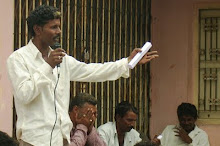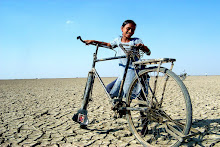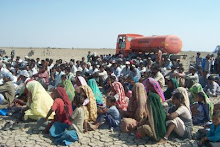Counterview: Ahmedabad: Thursday, March 20, 2014.
 |
| An agariya in the Little Rann of Kutch |
The agariyas
or salt-pan workers of Gujarat, who produce salt in the Little Rann of Kutch,
face a dangerous predicament, hitting their livelihood. As on April 1, 2014,
the Indian Railways is all set to close down the facility provided to more than
15,000 small salt producers to transport salt to the rest of India. Despite
representations to the railway minister, Congress members of Parliament
Madhusudan Mistry and Somabhai Patel, and Congress vice-president Rahul Gandhi,
the Indian Railways has declared that the Kuda public siding in Surendranagar,
which provides the facility thrice a month to transport salt, will be “closed”
with effect from April 1, 2014 and “no further notice will be given for
closure.”
What is
worse, according to sources close to the development, despite representations
to the Gujarat government, which promised to “do something” in the matter,
things have failed to move. On hearing a representation from the Agariya Heet
Rakshak Manch (AHRM), which works among the salt-pan workers, senior Cabinet
minister of the Narendra Modi government, Nitin Patel, agreed to write a
“strongly-worded letter” to the Government of India to not to stop the railway
line without the Gujarat government’s nod. However, shockingly, Sachivalaya
sources say, Patel “never wrote the letter”, allowing things to remain as they
were, as he "believes the issue is hot and will hit Congress".
AHRM’s
Harinesh Pandya told Counterview, “What is most unfortunate is that, Rahul
Gandhi, during his visit to the Little Rann of Kutch on March 12, heard only
those representatives of the salt-pan workers who had for long stopped
championing their cause.” He added, “AHRM workers wanted to represent to the
Congress vice-president about the dangerous predicament in which the salt-pan
workers might themselves in very soon. However, they were stopped those
surrounding him. They did manage to meet him, but had to return after handing
over a letter of demands which stressed on continuing with the railway
facility. They have not received any answer from the Congress vice-president on
the matter.”
Meanwhile,
sources said, the BJP is fishing in the troubled waters. It is using the
“failure” of Gandhi to take up the problem of the salt-pan workers, on which
their future livelihood depends. Belonging to Surendrangar, Congress MP
Somabhai Patel’s letter on December 17, 2013, demanding from railway minister
Pawankumar Bansal, that urgent steps be taken to ensure that the railway
facility is not discontinued, is being cited as an example of the Congress
failure. The letter made no impact. Patel’s letter had said, by stopping the
facility, the small producers’ small business would come to a grinding halt.
Again fighting on Congress ticket, sources said, Patel’s failure is pushing
thousands of salt-pan workers and their dependents to the BJP. Majority of
agariyas belong to the backward koli community, to which Patel also belongs.
AHRM in its
letter to the railway minister in late-January had explained why making
organic, crystal salt by the traditional method has been prime livelihood
source for over 15,000 agariya families (75,000 people) in the Little Rann of
Kutch. “Agariyas primarily belong to nomadic and de-notified tribes. They are
chunvaliya kolis, miyanas, and sandhis”, said the letter, adding, “Communities
migrate from over 140 villages of Surendrangar, Patan, Kutch and Rajkot
districts in the month of September to make salt pan using sub-soil brine.
Eighty per cent of agariyas are landless, carry huge social stigma of belonging
to nomadic and de-notified tribe category, are very poor. They do not have
access to formal credit and are completely depend on the local money lending,
to whom they have to sell their salt in advance.”
 |
| Agariya women |
Already, the
agariyas face several livelihood problems, but this one is likely to affect
them directly.
Other
important issues they face, according to ARHM, are:
· Their
seasonal and customary rights over the Little Rann of Kutch, a protected area
and a sanctuary, should be recognized under the forest rights Act. Guidelines
should be issued so that Act is implemented in the Rann which is a unique
sanctuary, and is falling into non-forest area.
· Support
price for the salt should be declared. The current price which the producer
gets is as low as 24 paisa, which is actually less than the packing bag used
for the same.
· The
crop insurance scheme should also be on the agariya farms producing salt, as
they have to bear the brunt of natural calamities like dust storm and
un-seasonal rain.
· Diesel
is being used for pumping of sub-soil brine which becomes a major part of
production cost for the agariyas. Solar technology may be promoted, which is
green energy; it will reduce the agariyas’ production cost and their dependency
on private moneylenders.
· Technology
for improving salt quality and recovery of by-product should be made available
to the community free of cost. The technology has been developed by the Central
Salt Marine chemicals Research Institure (CSMCRI), Bhavnagar.
· The
Hindustan Salt, a Central public sector undertaking, has 23,000 acres of land.
This land was once allotted for salt production. The company has decided to
sub-lease the same for solar power plants. Instead, this land should be given
on lease to the agariyas, and the Hindustan Salt should purchase salt from the
agariyas at a support price.
















.jpg)
.jpg)
.jpg)
.jpg)













No comments:
Post a Comment